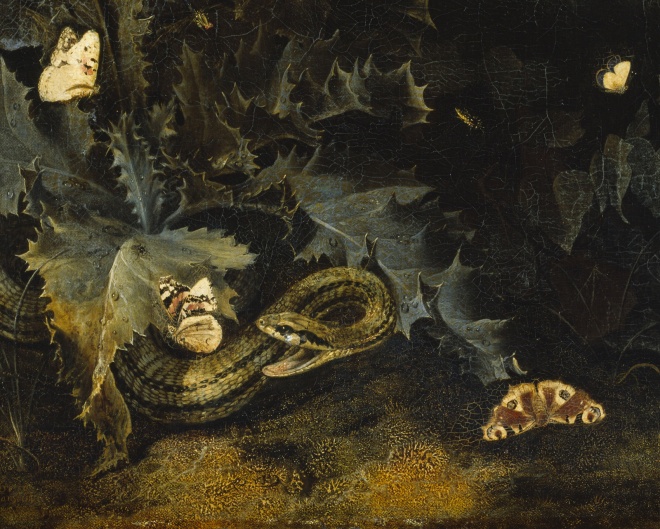
Otto Marseus van Schrieck: Forest Floor with Thistle and Snake (detail), circa 1665
We’re continuing our deep dive into the Ashtavakra Gita. It really is a lovely text, reminding us over and over again that what we are is so much more interesting than what we are not. This despite cultural conditioning that tricks us into thinking we are what we think, believe, remember, etc…
I’m currently down with a bad cold and feel kind of awful. Just a few days ago I was not down with a bad cold and felt kind of great. Is one more real than the other? They sure feel different. But the me who’s feeling, the me sitting inside my awareness, this “me” feels exactly the same.
This me is so much deeper than transitory states of sickness and health, loss and gain, happy and sad, up and down. It just sits here, resting in its own light. Steady, vibrant, and crystal clear…
We all know this. But the way the mind works, we need to be reminded over and over again. And the Ashtavakra Gita is a great medicine for remembering…
Along with this text, I also referenced everybody’s favorite, the five primal causes of suffering known as the kleshas. These are spelled out in the yoga-sutra. If you need a refresher on these lovelies, here you go:
Avidya is the lens that clouds our ability to know what we truly are, keeping us caught in the forest of ignorance…
Asmita is the lens that tricks us into small self identification, i.e. the ego or “I-maker.”
Raga is pleasure, which, when tangled up with avidya and asmita, gets us all caught up in clinging to what makes us feel good.
Dvesha is aversion, which when tangled up with avidya and asmita, creates a profound separation from everything and anything we label as “bad.”
Abinivesha is clinging to life (or any situation) because we fear death (or change).
Because the Ashtavakra Gita is such a love song to the Self, we’ve been mostly chanting om namah shivaya. Which is such a sonic embodiment of the Self…
Here’s opening chanting. This is very slow ONS.
Here is this week’s dharma talk.
Here’s the text we read from Ashtavakra Gita.
8.
“I do this. I do that.”The big black snake of selfishnessHas bitten you!“I do nothing.”This is the nectar of faith,So drink and be happy!9.Know you are one,Pure awareness.With the fire of this conviction,Burn down the forest of ignorance.Free yourself from sorrow,And be happy!10.Be happy!For you are joy, unbounded joy.You are awareness itself.Just as a coil of ropeIs mistaken for a snake,So you are mistaken for the world.11.If you think you are free,You are free.If you think you are bound,You are bound.For the saying is true:You are what you think.12.The Self looks like the world.But this is just an illusion.The Self is everywhere.One.Still.Free.Perfect.The witness of all things,AwarenessWithout action, clinging or desire.
Here’s the Mary Oliver poem that sums it up way more eloquently
than I am able…
OUT OF THE STUMP ROT, SOMETHING
Mary OliverOut of the stump rot
something
glides forward
that is not a rope,unless a rope has eyes,
lips,
tongue like a smack of smoke,
body without shoulders.Thus: the black snake
floating
over the leaves
of the old yearand down to the pond,
to the green just beginning
to fuzzle out of the earth,
also, like smoke.If you like a prettiness,
don’t come here.
Look at pictures instead,
or wait for the daffodils.This is spring,
by the rattled pond, in the shambled woods,
as spring has always been
and always will beno matter what we do
in the suburbs.
The matted fur,
the red blood,the bats unshuttering
their terrible faces,
and black snake
gliding across the fieldyou think you own.
Long neck, long tail.
Tongue on fire.
Heart of stone.[from A Thousand Mornings]
